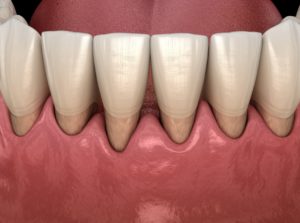Why is Gum Grafting Necessary for Periodontal Disease?
January 28, 2022
 Tooth decay is not the only threat to your dental health. Gum (periodontal) disease can wreak havoc on your smile and body. Although it’s preventable, the Centers for Disease Control and Prevention reports at least 50% of adults have the infection, making it the leading cause of tooth loss. Thankfully, your periodontist in Huntington Beach can save your smile before it’s too late. In addition to periodontal therapy, you may also need gum grafting. Although it might sound a little scary, you don’t have anything to fear. Here’s what you need to know to feel confident about the road ahead.
Tooth decay is not the only threat to your dental health. Gum (periodontal) disease can wreak havoc on your smile and body. Although it’s preventable, the Centers for Disease Control and Prevention reports at least 50% of adults have the infection, making it the leading cause of tooth loss. Thankfully, your periodontist in Huntington Beach can save your smile before it’s too late. In addition to periodontal therapy, you may also need gum grafting. Although it might sound a little scary, you don’t have anything to fear. Here’s what you need to know to feel confident about the road ahead.
Repairing the Damage of Gum Disease
Gum disease is caused by bacteria found in plaque and tartar buildup from poor oral hygiene habits. At first, the buildup will irritate the gum tissue, causing bleeding, swelling, and tenderness. Although the signs of gingivitis may not seem alarming, the infection can destroy your gum tissue and the supporting structures of your teeth without any treatment. Over time, your teeth can fall out.
As the infection progresses, it will cause your gum tissue to pull away from your teeth, exposing the roots. Receding gums can leave your teeth vulnerable to sensitivity and decay. A gum graft can treat gum recession to ensure your teeth have the protection and support they need.
The surgical procedure grafts tissue from a donor or another area of the body onto the treatment area. As your mouth heals, the graft will integrate with your natural tissues to cover the exposed roots to seal them from future complications. The graft will also enhance your gum line to restore a beautiful, confident smile.
Rehabilitating Your Gum Health
Your periodontist will examine your mouth to create a personalized strategy to rehabilitate your smile. They’ll determine the best type of graft for your needs, which may include:
- Connective-Tissue Graft: This is the most common method used to treat gum recession. A piece of subepithelial connective tissue is removed from the roof of the mouth and stitched to the gum surrounding the exposed root.
- Free Gingival Graft: A small amount of tissue is removed directly from the upper palate and attached to the treatment area. This method can be recommended for patients who have thin gums.
- Pedicle Graft: Tissue is taken from the gum near the tooth. A flap is created, allowing the tissue to be pulled over the exposed root and stitched in place.
In some situations, your periodontist may prefer using a graft material from a tissue bank instead of your own. Don’t worry, they’ll explain everything during your consultation for gum grafting to calm your nerves.
Meet Dr. Justin Braga
Dr. Braga earned his dental degree at the University of the Pacific in San Francisco before continuing his training in periodontics at the University of California. Dr. Braga has received recognition from the California Society of Periodontology because of his research in dental implants. If you have a complex oral health issue, Dr. Braga has the qualifications you can trust. Contact our office today to schedule your consultation.
No Comments
No comments yet.
RSS feed for comments on this post.
Sorry, the comment form is closed at this time.
